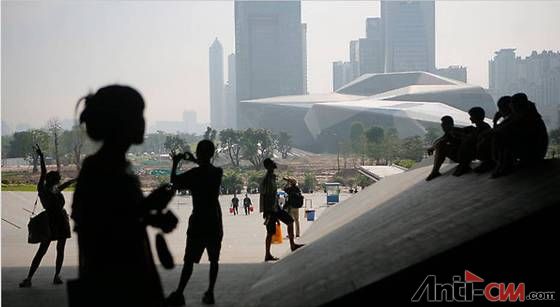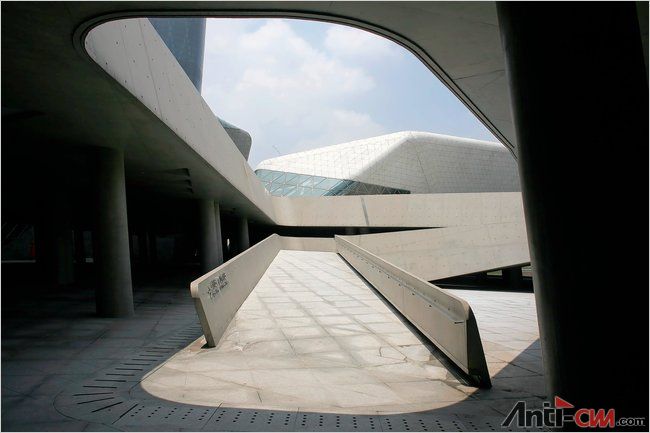本帖最后由 满仓 于 2010-8-4 12:48 编辑
【中文标题】艺术坊在中国兴起
【原文标题】Arts Playground Sprouts in China
【登载媒体】纽约时报
【原文作者】JOYCE HOR-CHUNG LAU
【原文链接】http://www.nytimes.com/2010/08/04/arts/04iht-guangzhou.html?_r=1&ref=china

广州歌剧院远景,拍摄处为新开放的广东博物馆。
香港一直把广州视为它在大陆的穷亲戚,但是当这个富足的前英国殖民地几年以来在建设一个大规模的文化区域没有任何进展的时候,广州提前了一步,已经建成了一个文化区。
这个被工厂城镇所包围的城市,在今年春天新开放了广东博物馆和广州歌剧院,还有一个现成的公共图书馆和一个儿童艺术中心。
政府并未公开这些项目的造价,媒体估计这四座建筑物大约花费了34亿人民币,大约5亿美元。广州计划在11月份亚运会开幕时向公众推出这片区域。
计划是这样。就像中国所有的事情一样,硬件先就绪,软件慢慢来。
在博物馆向公众开放几个月之后的5月份,工人们还在尘土和废墟中施工,修建这个区域的其它部分。歌剧院和博物馆的开业实际上是两座漂亮的建筑物模型矗立在一片垃圾场中,运输转运中心、出租车站和人行道都没有完工,尤其是在坏天气歌剧院演出结束的时候,人群和交通都会发生堵塞现象。
博物馆的设计者是香港建筑师Rocco Yim,他说造价是9亿人民币。宇宙飞船造型的歌剧院的设计者是伦敦建筑师Zaha Hadid,造价14亿人民币。Rocco Yim站在博物馆入口处,指着歌剧院说:“两座建筑物之间由一条宽阔的林荫步行道连接,人们可以在绿色的环境中从歌剧院走到博物馆。这边还有一大片坡地,人们可以躺在草地上休息。道路上的车辆会从地下分流,以减少路边的污染。”
博物馆是一个巨大的立方体,表面是灰色和红色的装饰块,在晚上亮起鲜红色的灯光。Yim先生说:“我希望制造出一种中国珠宝漆盒的感觉,一个精致的容器,里面有宝贵的东西。”
自然光线透过不规则形状的空隙和天窗投射到博物馆内部。大厅上面悬空设计有人行通道和方形的走廊。分隔空间的不是墙壁,而是半透明纱网,增加的空气的流动性。
广东博物馆的藏品里没有引人注目、价值连城的宝物——当然比不上台北故宫中的藏品。但是这里有更多的中国南方民间艺术品,比如潮州木刻、书法和水墨画,自然历史部分也很照顾孩子们的需要。Yim先生说他最喜欢的房间是巨大的门厅,那里有实物大小的鲸鱼和海豚标本,挂在天花板上,笼罩在蓝色的光线中。从那里你可以一直看到下面一层的恐龙化石。
歌剧院的建筑美学与方方正正的博物馆正相反——全部是扭曲的银色曲线条。布满方格子的外立面包括两座建筑物:一个大型歌剧院和一个小型音乐厅。
广州歌剧院的发言人刘晓路说:“这里的文化景观一直是相对缺乏的,我们在很短的时间内就改变了这个局面。之前只有北京和上海才有这样的建筑。大型的国际演出,无论是歌剧还是流行音乐,都会通过我们进入香港。我们只是没有合适的场地,甚至没有足够大的舞台让《天鹅湖》中所有的天鹅演员登台亮相。现在,该轮到广州了。”
刚开始的两个月里,这里承办了三场全景歌剧,上座率都差强人意。刘先生说,首场演出是普契尼的《图兰朵》,有不少香港观众前来观看。
一旦国家出资兴建昂贵的项目,总会有一些有关其必要性的问题冒出来。新加坡的中文报纸《联合早报》在一篇评论员文章中问道,《图兰朵》的最高票价是2880元人民币,这出现在一个平均月收入为3942元人民币的城市中是否恰当?
《图兰朵》大概算是一个例外,因为这是歌剧院的首场演出盛会,而且乐队指挥是Lorin Maazel。大部分票款都进入了官方、主办者和其它VIP的口袋。
但是歌剧《花木兰》呢?这是一个国内作品,已经巡回演出了若干年,最好的座位也要买到1200元人民币。

广州歌剧院的内部景观。
广州歌剧院坚持认为他们向学生和低收入人群提供了一系列的折扣演出票。例如,对于即将上演的加拿大歌剧《爱丽丝漫游仙境》,主办方承诺在四场演出中的两场里,为低收入居民预留一些座位。刘先生说:“这绝对是一个公共建筑设施。”
在中文里,“广州歌剧院”这个名称其实与歌剧无关,或许应当翻译成“广州艺术演出中心”。这里即将上演的剧目包括现代舞、多媒体展示、流行艺术和类似“现场芝麻街”这种儿童节目。发言人说这里还会上演粤剧,演出团体来自香港或澳门。
从平衡艺术造诣和公众鉴赏力的角度来看,歌剧院上演《花木兰》绝对是明智之举,演出的上座率约为80%。这是电视观众最喜爱的一个中国故事的歌剧版本。无论是穿着颜色亮丽的丝袍的勇敢女战士、牡丹花枝叶的背景,还是长城落日的场景都拨动了每一个观众的心弦。
穿着燕尾服的指挥站在聚光灯下,他指挥的合唱和乐队作曲都是西方式的。但是演唱方式和打击乐的音量无疑包含了中国元素。
或许只有足够震撼力的鼓声才能在观众的窃窃私语声、电话铃声、孩子们在走廊的玩闹声和人们偷偷摸摸寻找好座位的声音中脱颖而出。《金融时报》5月份对《图兰朵》演出的报道中特意提到了现场过分嘈杂的现象,比如用闪光灯拍照和保安对讲机的声音。
与此同时在广东博物馆,教育和宣传主任王晓颖估计每天的参观者有7000到8000人。
建筑物的施工完全结束之后,人们将可以从一层入口处进入,那里是连接歌剧院的绿色步行道。现在,他们只能在用金属栏杆围起来的等待处排队进入。
尽管如此,在一个闷热的星期天下午,博物馆的队伍也排到了街上。一位广州市民刘进说他已经等待了20分钟,“当然值得了,这是免费的。而且,每个大城市都有大型的博物馆,现在我们也有了。”
原文:
A view of the Guangzhou Opera House, seen from the entrance of the newly opened Guangdong Museum.
GUANGZHOU, CHINA — Hong Kong has always looked down on Guangzhou as its poor mainland cousin. But while the affluent former British colony has stalled for years over plans for a massive cultural district, Guangzhou has gone ahead and built one.
This southern Chinese city surrounded by factory towns opened its new Guangdong Museum and Guangzhou Opera this spring. On tap are a public library and a children’s art center.
The government has not put a price tag on the entire project, though media reports have estimated that the four venues will cost 3.4 billion renminbi, about $500 million. Guangzhou hopes to unveil the complex by November, when it plays host to the Asian Games.
That is the plan. As is usually the case in China, the hardware was built first and the software is still on its way.
Months after the museum’s opening in May, workers are drilling and hammering amid piles of dirt and rubble to prepare the rest of the complex. The opera house and the museum are open for business — two beautiful architectural models rising from a junkyard. But the transport hub, taxi stands and pedestrian walkways have not been completed, causing crowd and traffic problems, particularly when the opera lets out in bad weather.
Rocco Yim, the Hong Kong architect who designed the museum, reported to cost 900 million renminbi, stood at its entrance and pointed past the construction site to the spaceship-like opera house designed by the London-based architect Zaha Hadid for an estimated 1.4 billion renminbi. “The two will be connected by a wide pedestrian avenue,” Mr. Yim said, “so people can walk right from the opera to the museum through open green space. Here will be a large slope where people can lie down in the grass. Roadside pollution will be cut down by diverting vehicular traffic underground.”
The museum is an enormous cube made of gray and red puzzle pieces that light up with a scarlet glow at night. “I wanted to create the feeling of a lacquered Chinese jewelry box,” Mr. Yim said, “an exquisite container holding valuables inside.”
Natural light floods the museum through its jigsaw-shaped holes and skylights. A walkway and a cube-shaped gallery float above the lobby. Spaces are divided not by walls but by translucent screens, adding to the airiness.
There is no stand-out, priceless treasure in the Guangdong Museum’s collection — certainly nothing comparable with the Palace Museum in Taipei, say. But there is much southern Chinese folk art, like Chiuchow wood carvings, calligraphy and ink paintings, and the natural history section is definitely child-friendly. Mr. Yim said his favorite room is the vast atrium where life-sized models of whales and dolphins are suspended from the ceiling, flooded in blue light. From there you can look straight down to the dinosaur fossils displayed on the floor below.
The opera house — all silvery twists and curves — is the aesthetic opposite of the squarish museum. Its latticework skin covers two structures: a large hall for operas and a concert hall for recitals.
Liu Xiaolu, a Guangzhou Opera spokesman, said: “In a short period of time it has changed the cultural scene here, which was relatively limited until recently. Before it was just Beijing and Shanghai. Major international productions — whether it was opera or pop music — would pass right over us and go straight to Hong Kong. We just didn’t have the venues. We didn’t even have a stage large enough to fit all the swans in Swan Lake. Now it’s Guangzhou’s turn.”
In its first two months, the house put on three fully staged operas, all of which were well attended. Mr. Liu noted that they had a good number of visitors from Hong Kong for the opening show, Puccini’s “Turandot.”
Whenever an expensive project is built with state money, questions are raised about its relevance. Lianhe Zaobao, a Chinese-language newspaper in Singapore, asked in an editorial whether top ticket prices for “Turandot,” at 2,880 renminbi, were appropriate in a city where the average monthly salary is 3,942 renminbi.
Arguably, “Turandot” was an exception, as it was the venue’s opening gala and was conducted by Lorin Maazel. Plus, many of the tickets went to officials, organizers and other V.I.P.s.
But even for the “Mulan” opera — a domestic production that has been on tour for several years — the best seats cost 1,200 renminbi.
A view of the Guangzhou Opera House.
The Guangzhou Opera countered that it has offered a range of discounted tickets for students and the disadvantaged. In an upcoming Canadian production of “Alice in Wonderland,” for instance, a donation from a corporate sponsor allowed seats for two of the four shows to be set aside for disadvantaged residents. “This is definitely a public facility,” Mr. Liu said.
In Chinese, the Guangzhou Opera’s name actually says nothing about opera — it is probably better translated as the Guangzhou Center for Performing Arts. Its roster of future events includes modern dance, multimedia shows, pop acts and children’s programming like “Sesame Street Live.” The spokesman said the house also is hoping to stage Yue Opera, or Cantonese Opera, with troupes from Hong Kong or Macao.
In terms of balancing artistic ambition with public sentiment, the opera house got it right with “Mulan,” which was about 80 percent full. It was the operatic version of the Chinese costume melodramas so loved by television audiences. It pulled at every populist heartstring, from the plucky woman warrior in a bright silk robe to the backdrops of peony branches and a red sunset over the Great Wall.
The composition for chorus and full orchestra — complete with a conductor in tails highlighted by a spotlight on stage — is Western. But there was a definite Chinese influence to the singing style and the volume of the percussion.
Or maybe the drums were there to drown out the crowd’s babbling, of telephones ringing, of children playing in the aisles and of people trying to sneak into better seats. A review of “Turandot” in the Financial Times in May made note of the myriad distractions, like flash photography and the static of the security guards’ walkie-talkies.
At the Guangdong Museum, meanwhile, Wang Xiaoying, the director of education and promotion, estimated that the venue was getting 7,000 to 8,000 visitors a day.
When construction is finished, people will be able to enter from the ground-floor entrance that is linked to the grassy area and the walkway to the opera. For now, they are herded into a waiting area ringed with metal barriers.
Still, on a sweltering Sunday afternoon, the line stretched down the street. Liu Jin, a Guangzhou resident, said he had been waiting 20 minutes to get in. “Of course it’s worth it to see,” he said. “It’s free to the public. Plus, every big city has a big museum and now we do, too.” |